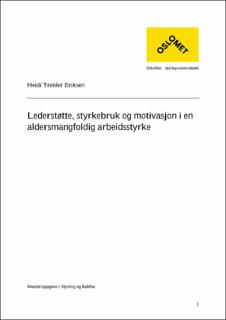| dc.description.abstract | In a company there is often a choice between increasing efficiency and revenue or increasing the workers wellbeing. The optimal choice would be if both could be achieved at the same time. One possible way to do this is to focus on increasing the workers motivation. There have been found a positive link between increased employee motivation and improvements in work results (Van den Broeck et al. 2010). In this study I examine the correlation between perceived leader support for strengths use, employees’ strengths use, intrinsic motivation and how the variable age influences these relationships. This has been examined by analyzing results from a two-part survey, with 1048 and 643 responses (part 1 and 2). The findings confirm several of our hypotheses.
I found that perceived leader support for strengths use is associated positively with the employees’ strengths use, and that strengths use is associated positively with intrinsic motivation. There is also a positive relation between perceived leader support for strengths use and intrinsic motivation, but the results show that there is a partial mediation on this relation from the strengths use variable. In addition, we find that age serves as a moderator to the relationship between perceived leader support for strengths use and strengths use. The moderator is such that a younger employee has a greater benefit to their strengths use from leader support than what an older employee has. With a positive connection between strengths use and intrinsic motivation, support from the leader is more strongly associated with younger employees’ motivation than it is to older. There was also a smaller, but still positive connection between the older employees’ level of strength and the level of perceived leader support for strengths use.
It is worth looking into the implications of this. There is a detectable difference in how employees respond to a leaders’ support of their strengths use. If we assume that a high level of motivation is preferable, then adapting the level of, or type of, support to the employees age might be an important help. If a leader manages to give support in identifying and activate the younger employees’ strengths, this could give a great motivational boost. But if a leader tries the same tactic with an older employee, it might not have the same effect on that employees’ strengths use.
However, the relationship between strengths use and intrinsic motivation is not a completely correlated one. There are several other variables that influences intrinsic motivation, among others a direct effect from perceived leader support from strengths use. This paper looks into the subject of strengths use and intrinsic motivation, with the underlying wish to identify ways of improving conditions for both employees, employers and the society as a whole. | en_US |
